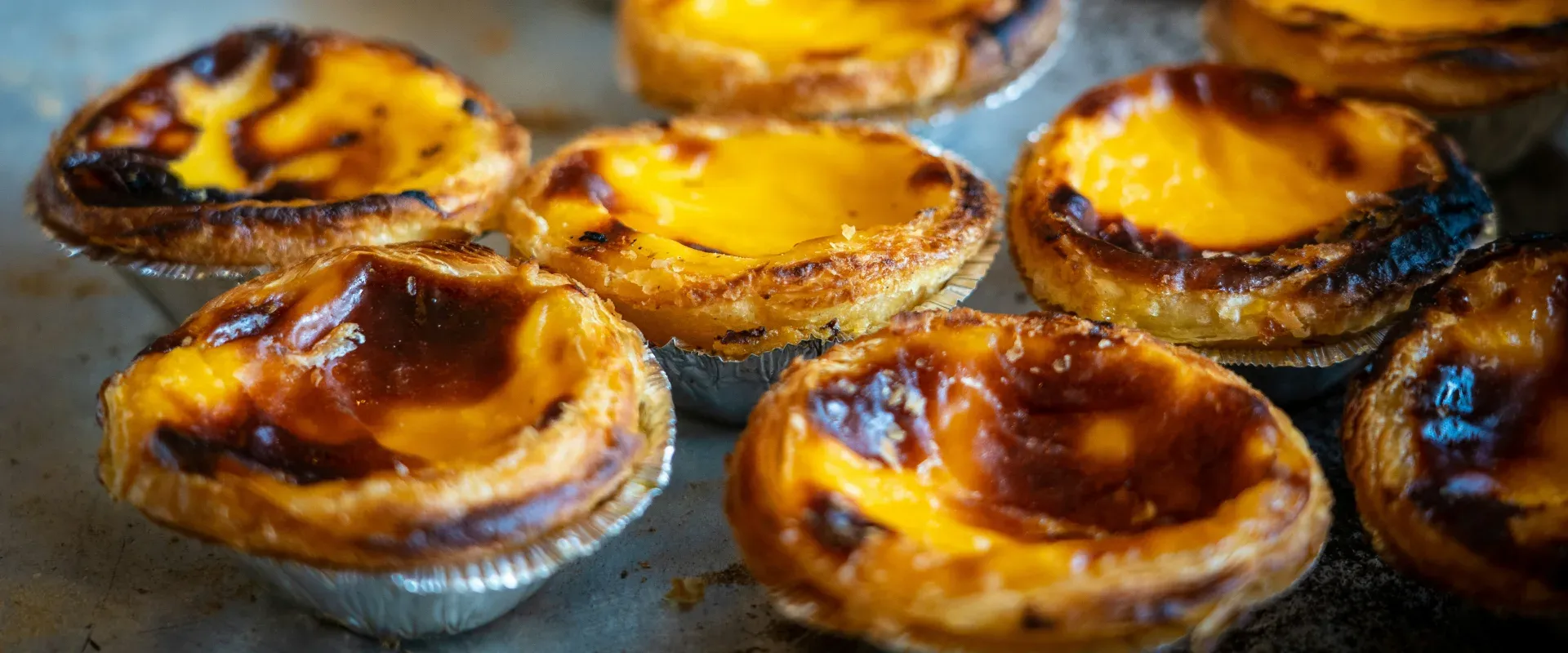
What To Eat in Portugal: 15 Must-Try Dishes
Portuguese cuisine has been shaped by centuries of seafaring. Phoenicians introduced viticulture and olives, the Romans established vast wheat fields and fish-salting factories, and North African Muslims brought rice, figs, and nuts. Later, in the Age of Discovery—Portugal’s empire-establishing years between the 15th and 17th centuries—all four corners influenced the nation’s dishes.
Salted codfish from Newfoundland became a cherished staple. Tropical fruits, tea plantations, and coffee farms were planted on Portugal’s Macaronesian archipelagos, which comprise the Azores and Madeira, in addition to Spanish and Cape Verdean territories. And the arrival of piri piri in the Algarve, mainland Portugal's most southerly region, added African spice to the table.
Nowadays, Portugal’s gastronomy is magnificently simple and utterly contradictory. Traditional recipes are fiercely defended, while an ever-growing clutch of innovative chefs recently earned Portugal its first dedicated Michelin guide. It’s an Atlantic-facing country with a Mediterranean diet—yet Nordic cod is the national obsession. And age-old pastries invented by nuns and monks are perhaps more famous than the UNESCO landmarks from which they come. Here’s what to eat in Portugal to taste its past and present—from provincial plates to national delicacies.
Bacalhau

Bacalhau—dried and salted codfish—is Portugal’s culinary constant. From upscale restaurants to low-key, family-run tascas (affordable, homely eateries), this faithful staple is the protagonist of nearly every menu. Cod is so entrenched in Portuguese gastronomy that most wouldn’t dream of eating anything else for consoada, the Christmas Eve dinner. Yet, somewhat bizarrely for a country with the Atlantic’s bounty on its doorstep, Portugal’s most prized fish isn’t found in local waters. It’s imported from Nordic nations.
Just like in the 15th century, when cod from Newfoundland was salt-preserved to survive long sailings home, it’s still favored cured today—ideally salted from 6–9 months. Then, before cooking, the fish is soaked for a day or two to remove the saline flavor. Many call bacalhau Portugal’s unofficial national dish, while others stress that it’s merely an ingredient—something the hundreds of codfish recipes support.
Some of the most common interpretations are Lisbon’s Bacalhau à Brás, shredded with julienne potatoes and beaten egg; the north’s Bacalhau à Gomes de Sá, flaked with potato slices, olives, and boiled eggs; and the Beiras’ Bacalhau à Lagareiro, baked filets with lashings of olive oil and onions. Pastéis de bacalhau, small codfish pastries similar to croquettes, are an ideal bite-sized introduction or on-the-go snack.
Just-caught Atlantic seafood

Closer to home, Portugal’s Atlantic Ocean provides abundant fresh fish—often priced depending on the day’s catch. Pair this with the Mediterranean diet, and you have a recipe for some of the most simply prepared yet delicious seafood. Marisqueiras (seafood restaurants) or cervejarias (typical beer halls usually renowned for their shellfish offerings) are the best places to share a seafood feast. The likes of Lisbon’s Cervejaria Ramiro is an indulgent treat—yet it’s equally casual. Sucking the juice from the head of a plump Carabinero prawn and ending the meal with a prego (beefsteak sandwich) will earn you respect rather than judgment here.
Piled high on any seafood platter is a taste of the entire country’s coast. The Algarve’s marshy Ria Formosa hides countless razor clams, Aveiro is renowned for its fatty oysters, percebes (goose barnacles) from the Berlengas Islands are exceptional, and on the archipelagos, lapas grelhadas (grilled limpets) rule supreme. In Lisbon, where the Tagus River teems with clams, Amêijoas à Bulhão Pato—clams with olive oil, cilantro, and garlic—is one of the most emblematic standalone dishes.
Sardines

Sardines deserve special mention—they’re practically part of Portugal’s soul. For the best sardinhas assadas (grilled sardines), head south to Portimão, where the riverbank boasts plenty of dedicated restaurants, a museum inside a former canning factory, and even an annual sardine festival. Or, follow your nose in Lisbon’s Alfama district to find a small grill sizzling with rows of them. During June's animated Festa Santo António, Lisbon’s oldest quarter is seriously scented by sardines and soundtracked by pimba, humorous folk music. If sardines aren’t your flavor, then grilled robalo (sea bass), dourada (sea bream), and salmon are equally ubiquitous.
Not that fresh is always best. Portugal’s preserved tin offerings, known as conservas, are nearly as esteemed as their just-caught counterparts. Peel back the lid on a tin of oil-soaked anchovies, mussels, or sardines—Porto’s Pinhais is an excellent brand, as they still prepare and pack by hand—and pair with a lightly sparkling vinho verde for a perfect sunset treat.
Arroz de marisco or arroz de pato

Spain’s paella might be the Iberian Peninsula’s most famous arroz dish. Yet, it's the Portuguese, rather than their neighbors, who hold the title for Europe's highest rice consumption per capita. Cultivated in Portugal’s river estuaries for centuries—the sweeping rice paddies of Comporta are a unique day trip from Lisbon—rice features in countless dishes. Sometimes, it’s even a secondary starchy side alongside potatoes.
Seafood rice (arroz de marisco) is the most common, its recipe hailing from the small fishing village of Vieira de Leiria. Utilizing Portugal’s own-grown, long-grain Carolino rice, the recipe slowly simmers shellfish, tomatoes, bell peppers, and surplus herbs. However, unlike paella or risotto, the sauce isn’t fully reduced before serving, leaving the rice and seafood in a delicious stew-like state. If you’d prefer a fish-free alternative, order arroz de pato (duck rice), originally from the northern city of Braga.
Conventual sweets

Cristiano Ronaldo might be Portugal’s most famous face, but in culinary form, that accolade arguably goes to the pastel de nata. These creamy egg custard tarts, encased in a crispy, flaky pastry, are best freshly brûléed, ideally sprinkled with cinnamon. To taste these tarts in their birthplace, head to Pastéis de Belém—pastéis is the plural of pastel, handy as you’ll likely want at least two—in Lisbon’s Belém district. Sure, it’s touristy these days, but it’s an experience. Don’t let the long queues put you off; the interior is a labyrinth with hundreds of seats.
However, a baker didn’t write the recipe in this pastelaria—it was the brainchild of a monk in nearby Jerónimos Monastery. In bygone days, when egg whites were used to starch robes, the “wasted” yolks were turned into these oh-so-perfect tarts. When Portugal’s Liberal Revolution in 1820 closed convents and monasteries, the recipe transferred across the road, leading these egg pastries to become a countrywide obsession. But that wasn’t always the case. At one time, nearly every region in Portugal had its own conventual sweets (doçaria conventual), the collective name given to the egg-based treats created by nuns and monks.
In Aveiro, on the central-northern coast, shell-shaped ovos moles have been around since the 16th century, while central Alcobaça, which hosts the annual conventual sweets competition, claims its cone-like cornucópias date back to the 12th century. Not that the church commandeers all eggy treats. Some, such as Sintra’s pillow-shaped travesseiros, are secular.
Frango piri-piri

Elevating frango assado (roasted chicken), spicy piri-piri sauce is one of Portugal’s best creations—or is it? As with Portugal’s maritime past, it’s an intertwined and controversial topic. The bird's eye chilis used for the sauce originated in South America and were then transported and planted in Portugal’s African colonies. In Mozambique, the plant flourished, and it’s most probable that the first piri-piri sauce was created there, only arriving in the Algarve as a wave of settlers returned to Portugal in the 1970s.
Along the way, these zesty chilis were blended with olive oil, garlic, and vinegar (or citrus for acidity), creating one superior sauce. And now, although it’s a dish you’ll find nationwide, the Algarvian town of Guia claims to be Portugal’s Chicken Piri-Piri Capital.
For the best frango experience, eschew anything no forno (in the oven) and seek a smokey flavor in a churrasqueira (barbecue restaurant). Wafts of charcoal or wood-fire smoke are always a good sign. Better still, check if the chunks of spatchcocked chicken are served on a small silver plate with a thin pool of ochre oil—then you’ve found a winner. Some restaurants marinate the chicken, others baste it on the grill, and sometimes, you can request it plain with sauce on the side. No matter which way, it’s one of Portugal’s most deliciously unfussy dishes.
Francesinha

Porto’s residents are dubbed tripeiros (tripe eaters), which can be an alarming sign for squeamish diners. While this moniker hails from the old-school dish of Tripas à Moda do Porto, said to have been a staple when the city’s residents sent all their best cuts away with their sailors, it’s no longer Porto’s most famous plate. Instead, that honor falls to the Francesinha. And while this sandwich’s story might not be as valiant, it is a no less heavy dish.
Inspired by France’s Croque Monsieur, the name means “little Frenchie”—though little it isn't. The plated sandwich is a hulking mound of bread, cheese, linguiça sausage, and cured ham bathing in a thick beer gravy. Oh, and there’s an egg on top for good measure. Porto’s Restaurante A Regaleira is perhaps the best place to try this indulgent dish, as it was here that the recipe was conceived by Portuguese Daniel David da Silva, a return-emigrant from France, to offer a more affordable plate to Porto’s less affluent residents. Still, any of Porto’s cervejarias worth their salt will serve a first-class Francesinha.
Not that the Francesinha is Portugal's only notable sandwich. Other typical options, bound in a crusty roll, include the aforementioned “seafood dessert” prego, or bifanas, made from thin slices of pork simmered in garlic and wine, and the sande de leitão, stuffed with the Berias region’s most distinctive meat: suckling pig.
Porco Preto Alentejano

In Portugal’s Alentejo, where gentle grassy hills, wheat fields, and endless oak trees dominate, life is more laid-back than in Lisbon—both for residents and the free-roaming pigs. It’s from here that Portugal's share of Iberian Black Pork (porco preto) hails, so-called due to the domestic pig’s darker appearance—likely due to crossbreeding with wild boars. Raised on an acorn diet, the high-quality meat has an intense and nutty flavor, and if cooked well, almost melts in your mouth.
Some restaurants simply grill the pork with a sprinkling of salt. But one of the most typical provincial plates (more so in the Algarve) is Carne de Porco à Alentejana, where chunks of pork are paired with amêijoas brancas (small, sweet clams) in garlic, olive oil, and herbs. It’s simple yet sublime and warrants plenty of bread to mop up the sauce.
Cataplana de marisco

Cataplana is often used to describe a dish. However, the word refers to the typically-copper, clam-like, airtight cooking pot prevalent in the Algarve region since the Maghreb Muslim occupation; it’s somewhat similar to Morocco’s tagine. Lifting the scolding lid to reveal a steaming, bubbling medley of seafood and rich tomato sauce is one of Portugal’s greatest communal culinary delights—especially as this is a dish designed to share.
Although copper cataplanas are used for various recipes, including meat, the most representative version is “de marisco”—with seafood. The best versions will have an assortment of sweet clams, plump mussels, and head-on shrimps with a meaty monkfish. The salinity of the seafood blends with the bell pepper, onion, and generously seasoned tomato sauce to create a rich base. Try it near Olhão’s seafood market or at Meste Zé in Cascais for the freshest experience.
Cozido

In Portuguese cuisine, waste isn’t a word—every part of an animal has its place on the table. And when it doesn’t, a Cozido á Portuguesa is perfect for leftovers. A meat-heavy, one-pot stew that’s been around for centuries, a quality cozido has a base usually made with a fatty cut of beef. After that, anything goes: offcuts, feet, ears, cabbage, and potatoes are all piled high and slowly boiled together, allowing the juices of the meat to mingle and seep into the vegetables.
Each region's traditional version depends on which livestock was raised locally. However, the most exciting interpretation is eaten in the Azores. On the volcanic island of São Miguel, where geothermal activity bubbles below the surface, the Cozido das Furnas is lowered underground and covered with soil. Slow-steamed using the geothermal heat beneath the town of Furnas, this cozido is worth the wait, especially as Azorean beef is arguably the country’s best.
Polvo à Lagareiro

Octopus (polvo) is one of southern Portugal’s most prized plates, especially in and around the village of Santa Luzia. Set on the lagoon side of the Ria Formosa, a vast expanse of wetlands, marshes, barrier islands, and salt pans, the abundance of shrimp in this location draws the octopi to feed. For over a century, the residents of this quiet fishing village have been catching the octopus in alcatruz, traditional clay pots that sit in the shallow waters, though these days, modern baited traps are commonplace.
There are hundreds of ways to enjoy polvo, from cataplanas and rice dishes to fritters and small, cold salads. However, one recipe reigns supreme: Polvo à Lagareiro. Blissfully uncomplicated, the octopus is boiled until tender and then baked with potatoes, bay leaves, garlic, and (seemingly) a whole bottle of olive oil. In Santa Luzia, you’ll find polvo on every menu. Yet, one of the best traditional seafood restaurants in the Algarve is Restaurante Noélia, in nearby Cabanas de Tavira, captained by one of MasterChef Portugal’s judges.
Soups and stews

The humble soup is revered in Portugal and is a familiar and affordable start to most meals, especially the fixed-price “menu do dia.” From straightforward sopa de legumes, based on seasonal vegetables, to more complex caldeiradas (fish stews), slurping your way through Portugal’s stews and soups will earn you admiration. Some of the most prominent include caldo verde, a thick blend of Galician cabbage with chouriço (smoked pork sausage) and potatoes. Or feijoada à transmontana, a bean-heavy stew from Portugal’s north that was likely the predecessor to Brazil’s national dish.
In the Alentejo, Portugal’s hinterland wheat basket, bread is the basis of the best regional dish: Açorda. Stale, torn pieces of pão (bread) are soaked with boiling water, olive oil, garlic, and a generous clutch of cilantro, creating a thick-set, almost porridge-like soup—a hearty farmers’ meal come rain or shine.
Petiscos

Spain has its tapas, and Portugal has its petiscos. Deriving from the verb "petiscar"—to snack—these small plates are usually bigger than Spanish tapas. Ranging from typical sunset snacks to smaller versions of main dishes, petiscos offer the chance to sample Portuguese flavors in bite-size form.
One of the oldest examples of these bar snacks is peixinhos da horta, flour-coated green beans. Fascinatingly, Portuguese sailors introduced the recipe to the Japanese in the 16th century, which became the inspiration for tempura—tempero is the Portuguese word for seasoning.
As with much of the Portuguese menu, vegetarian pestiscos are limited. Popular meat choices include presunto (dry-cured ham) from the city of Lamego; alheira, a game sausage from the northern mountains; meat croquettes; and pica pau, marinated cubes of meat eaten with a toothpick. For fish fans, order choco frito (fried and breaded cuttlefish from Setúbal), octopus salad, or tinned conservas. And if you’re in Portugal between May and August, keep your eyes peeled for “há caracóis'' signs announcing the arrival of snails. These summer bowls of tiny snails swimming in a garlicky broth are nearly as welcome as beach season.
Cheeses

In the country that gave the world Port, it would be criminal not to indulge in a spot of cheese tasting—especially when paired with a glass of the fortified good stuff. Luckily, cheese is as championed as wine, and most regions have unique wheels. A few of particular note are Queijo Serra da Estrela, a mountain cheese made from sheep's milk; unpasteurized Queijo de Azeitão, an acclaimed buttery and semi-soft cheese from just south of Lisbon; and Queijo São Jorge, an Azorean cheese that makes the most of the island’s free-roaming, high-quality cattle.
Arroz doce

Desserts are plentiful in Portugal, and Christmas wouldn’t be Christmas without a “cake table,” spread with a dozen or so sweet treats. Yet it's arroz doce, sweet rice, which is most common. This simple recipe calls for Portuguese short-grain rice, milk, sugar, and citrus to be blended and set. Served in a small bowl with a mandatory sprinkling of cinnamon, it’s a thick, creamy, and unfussy end to any meal before lingering over the final café (espresso) and much more conversation. Dining in Portugal is never rushed—eating is as much for the soul as the stomach.
Other Portugal guides
Last updated June 27, 2025
Articles you might like
View All
Best Day Trips from San Francisco: 25 Trips You’ll Actually Want to Take (2026)
Jan 6, 2026
12 min read

30 Free Things To Do In San Francisco That People Keep Recommending
Jan 6, 2026
10 min read

Marrakesh: The North African City Where Storytelling Is an Art
Jan 5, 2026
5 min read






